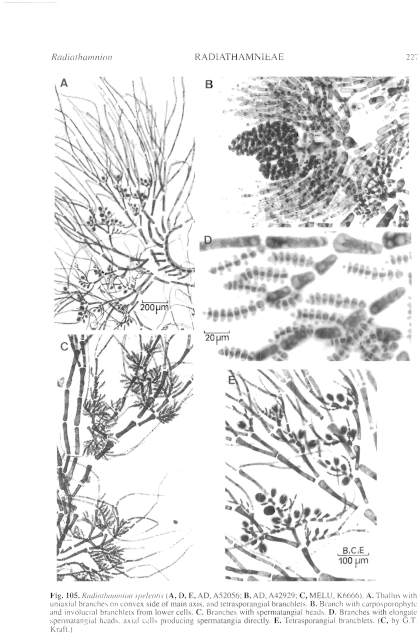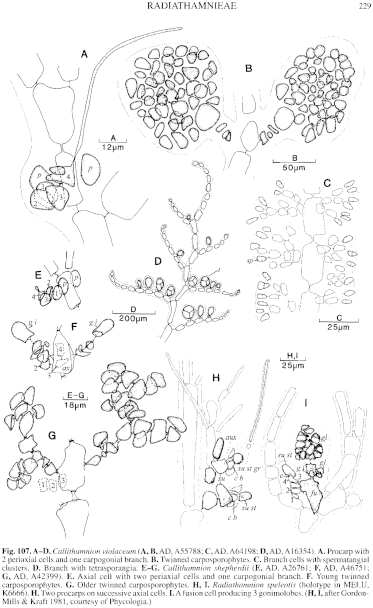|
|
|
|
|
|||||||||||
|
Electronic Flora of South Australia Species Fact Sheet
Phylum Rhodophyta – Order Ceramiales – Family Ceramiaceae – Tribe Radiathamnieae
Thallus (Fig. 105A) 1–2.5 mm high, red, growing from the apical pit of Laurencia spp., with a single prominent basal cell partly within the host tissue, producing a curved or arched main axis (Fig. 105A) 15–25 cells long, with most cells bearing unilaterally a single lateral branch on the convex side; branching dense to open, with laterals sub di- or trichotomously branched, the ends tapering to long hair-like, often caducous, ends. Epiphytic on various Laurencia species under moderate to rough-water conditions. Structure. Basal cell ovoid, 40–70 µm in diameter, cells of primary axis 25–90 µm in diameter and L/D 1–1.5, tapering slightly above, cells of lateral branches 17–40 (–80) µm in diameter and L/D 3.5–11 (often with rows of 1–3 swollen isodiametric cells), decreasing to hair like cells 8–12 µm in diameter and L/D 10–22. Cells uninucleate; rhodoplasts discoid to elongate.
Reproduction: Gametophytes dioecious. Procarps (Fig. 107H) borne on small-celled laterals on the secondary and tertiary branches, with the fourth or fifth subapical cell producing a 2–3 celled filament (terminal cell hair like) with the basal supporting cell bearing a 4-celled carpogonial branch. Post-fertilization the supporting cell may or may not divide to form an auxiliary cell, which produces a terminal and usually 2 lateral gonimolobes (Fig. 105B) 100–250 µm across, with ovoid to angular carposporangia 10–18 µm across; a basal fusion cell develops (Fig. 107I) and several involucral branchlets develop from 1 or 2 cells below the carposporophyte. Spermatangia (Fig. 105C, D) develop on elongate heads 10–12 µm in diameter and L/D 2.5–4.5, occurring mostly in pairs on small-celled branchlets, each with 7–11 axial cells most of which cut off directly 2–4 spermatangia.
Tetrasporangia (Fig. 105E) occur laterally (often unilaterally) on small-celled pectinate branchlets on laterals, often alongside elongate unicells, sessile, slightly ovoid, 35–45 µm in diameter, tetrahedrally, cruciately or decussately divided.
Type from Flinders, Westernport Bay, Vic., on Laurencia filiformis f. heteroclada, 1–2 m deep on jetty piles (Kraft & Ricker, 9.v.1978); holotype in MELU, K6666; isotypes in MELU, AD and UC.
Selected specimens: Marino, S. Aust., on Laurencia majuscula, 3 m deep (Owen & Kraft, 9.i.1973; AD, A42955). Margaret Brock Reef, Cape Jaffa, S. Aust., on Laurencia elata, 3–5 m deep (R. Lewis 29.xi.1972; AD, A42929 - "Marine Algae of southern Australia" No. 312). Marengo, Apollo Bay, Vic., on L. filiformis f. heteroclada, just above low tide in heavy surge (Ricker, 21.iv.1979; MELU and AD, A52057).
Distribution: Marino, S. Aust., to Flinders, Victoria.
References:
GORDON-MILLS, E.M. & KRAFT, G.T. (1981). The morphology of Radiathamnion speleotis gen. et sp. nov., representing a new tribe in the Ceramiaceae (Rhodophyta) from southern Australia. Phycologia 20, 122–130.
The Marine Benthic Flora of Southern Australia Part IIIC complete list of references.
Publication:
Womersley, H.B.S. (24 December, 1998)
The Marine Benthic Flora of Southern Australia
Rhodophyta. Part IIIC. Ceramiales – Ceramiaceae, Dasyaceae
©State Herbarium of South Australia, Government of South Australia
Illustrations in Womersley Part IIIA, 1998: FIGS 105, 107H, I.

Figure 105 enlarge
Fig. 105. Radiathamnion speleotis (A, D, E, AD, A52056; B, AD, A42929; C, MELU, K6666). A. Thallus with uniaxial branches on convex side of main axis, and tetrasporangial branchlets. B. Branch with carposporophyte and involucral branchlets from lower cells. C. Branches with spermatangial heads. D. Branches with elongate spermatangial heads, axial cells producing spermatangia directly. E. Tetrasporangial branchlets. (C, by G.T. Kraft.)

Figure 107 enlarge
Fig. 107. A–D. Callithamnion violaceum (A, B, AD, A55788; C, AD, A64198; D, AD, A16354). A. Procarp with 2 periaxial cells and one carpogonial branch. B. Twinned carposporophytes. C. Branch cells with spermatangial clusters. D. Branch with tetrasporangia. E–G. Callithamnion shepherdii (E, AD, A26761; F, AD, A46751; G, AD, A42399). E. Axial cell with two periaxial cells and one carpogonial branch. F. Young twinned carposporophytes. G. Older twinned carposporophytes. H, I. Radiathamnion speleotis (holotype in MELU, K6666). H. Two procarps on successive axial cells. I. A fusion cell producing 3 gonimolobes. (H, I, after Gordon-Mills & Kraft 1981, courtesy of Phycologia.)

|
Email Contact: State Herbarium of South Australia |

|